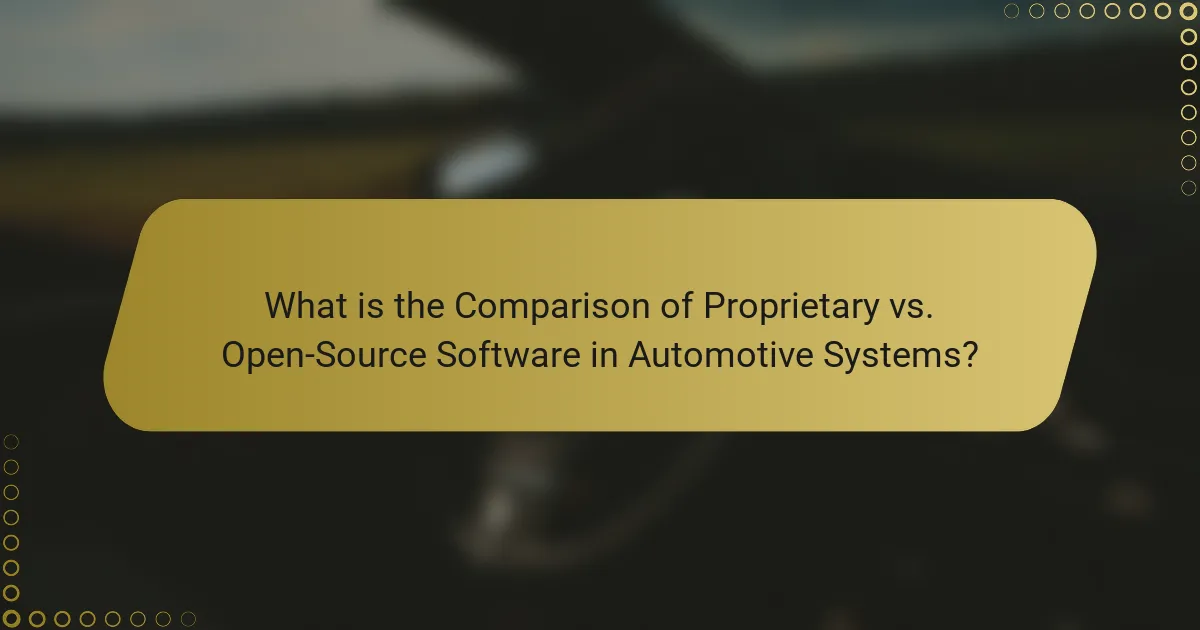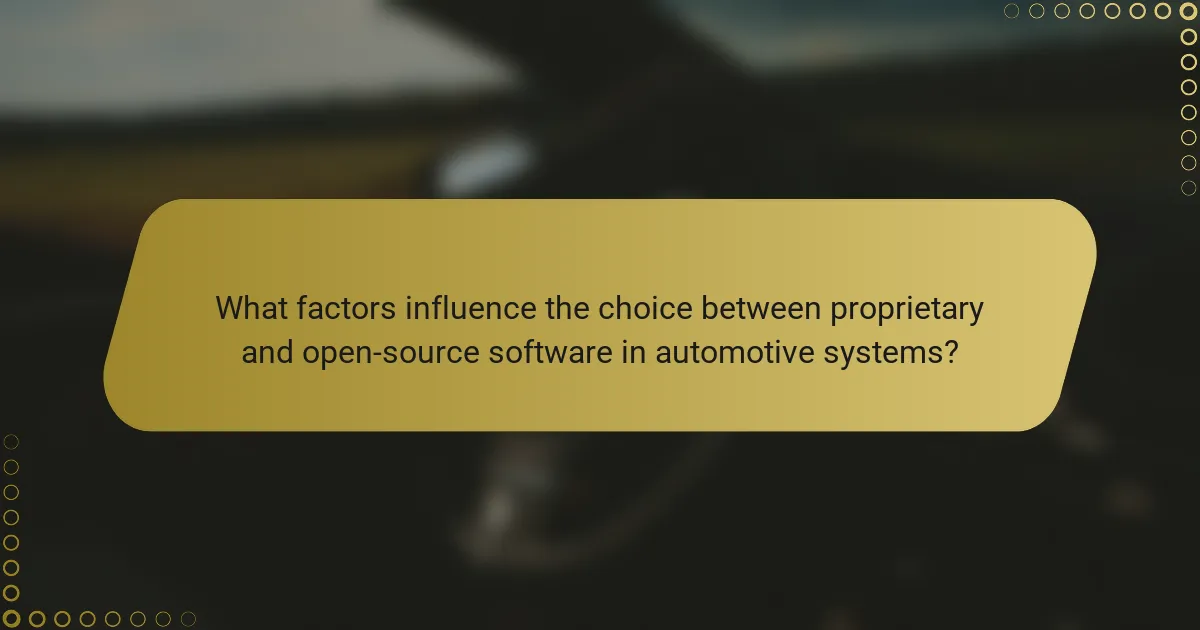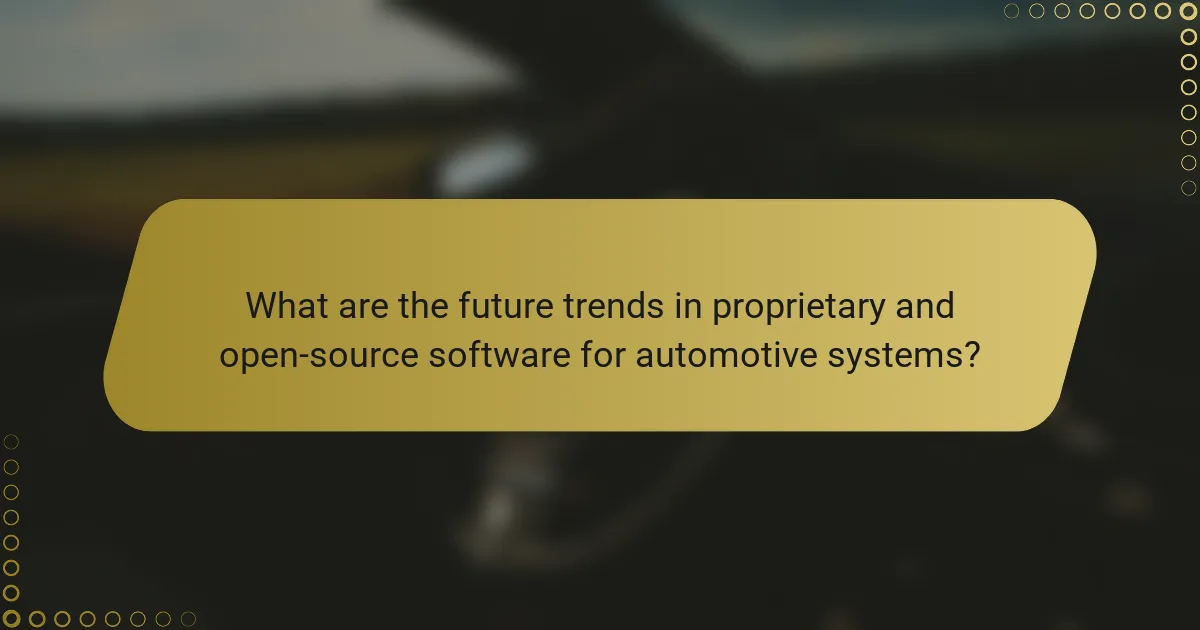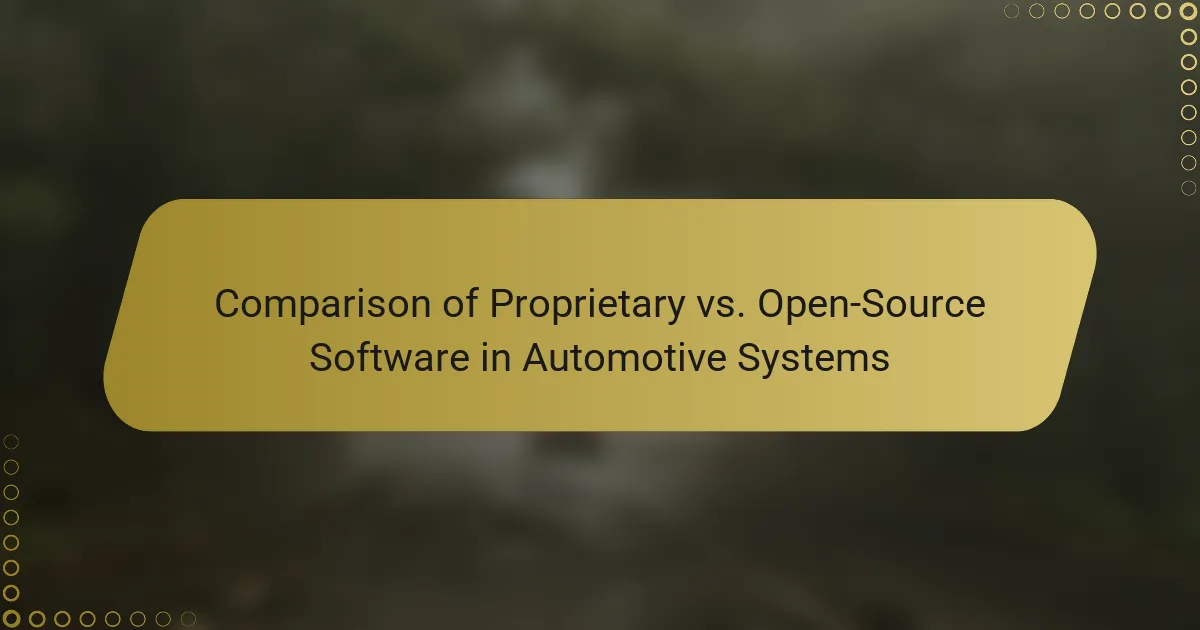The article compares proprietary software and open-source software in automotive systems, highlighting their distinct characteristics and implications for manufacturers. Proprietary software is developed and owned by a single entity, providing controlled updates and dedicated support, while open-source software allows users to access and modify the source code, promoting collaboration and innovation. Key considerations include cost, development speed, customization options, security, and vendor lock-in. The article also discusses future trends, such as increased collaboration, the importance of interoperability, and the impact of regulatory pressures on software transparency in the automotive industry.

What is the Comparison of Proprietary vs. Open-Source Software in Automotive Systems?
Proprietary software in automotive systems is developed and owned by a single entity, restricting access to its source code. This model allows for controlled updates and dedicated support, ensuring stability and security. For example, companies like Tesla use proprietary software to maintain exclusive control over their vehicle systems.
Open-source software, on the other hand, permits users to access and modify the source code. This fosters collaboration and innovation among developers. Projects like the Automotive Grade Linux (AGL) demonstrate how open-source can drive advancements in automotive technology.
Proprietary software often incurs licensing fees, while open-source can reduce costs for manufacturers. However, proprietary solutions may offer more robust customer support. In contrast, open-source software relies on community support, which can vary in quality.
In summary, proprietary software provides control and support, while open-source software encourages flexibility and innovation in automotive systems.
How do proprietary and open-source software differ in the automotive context?
Proprietary software in the automotive context is owned by a specific company and requires licenses for use. This type of software often comes with support and updates from the vendor. In contrast, open-source software is publicly available and can be modified by anyone. It encourages community collaboration and innovation.
Proprietary software typically has restrictions on usage and distribution. Users must adhere to licensing agreements. Open-source software allows for greater flexibility. Developers can customize it to meet specific automotive needs.
Proprietary software solutions may offer more polished user interfaces and dedicated customer support. However, they can be more expensive due to licensing fees. Open-source alternatives can reduce costs significantly but may lack comprehensive support.
In the automotive sector, proprietary software is often used for critical systems like engine control units. Open-source software is increasingly adopted for non-critical applications, such as infotainment systems. This differentiation reflects the varying levels of risk and reliability required in different automotive functions.
What are the defining characteristics of proprietary software in automotive systems?
Proprietary software in automotive systems is characterized by its exclusive ownership and licensing. This software is developed by specific companies, restricting access to its source code. Users cannot modify or distribute the software without permission. Proprietary systems often offer dedicated support and updates from the vendor. They may include advanced features tailored for specific automotive applications. Security measures are typically stringent, as the code is not publicly accessible. The software’s performance is optimized for the hardware it runs on, ensuring reliability. These characteristics contribute to a controlled environment for software deployment in vehicles.
What are the defining characteristics of open-source software in automotive systems?
Open-source software in automotive systems is characterized by its accessibility, transparency, and collaborative nature. It allows developers to view, modify, and distribute the source code freely. This fosters innovation and rapid development within the automotive industry. Open-source software often enhances security through community scrutiny, as many eyes can identify and fix vulnerabilities. Additionally, it supports interoperability with various systems and platforms. Cost-effectiveness is another defining trait, as it reduces licensing fees associated with proprietary software. Notably, organizations like the Automotive Grade Linux project exemplify successful open-source collaboration in automotive applications.
What are the advantages and disadvantages of proprietary software in automotive systems?
Proprietary software in automotive systems has distinct advantages and disadvantages. One advantage is enhanced security. Proprietary software is often less vulnerable to attacks due to limited access to its source code. Another advantage is dedicated support and updates from the vendor. This can lead to better performance and reliability in automotive applications.
However, there are disadvantages as well. One significant disadvantage is high costs associated with licensing fees. Manufacturers may face ongoing expenses for updates and support. Another disadvantage is limited customization options. Proprietary systems may not allow for modifications to meet specific needs or preferences.
In summary, proprietary software offers security and support but comes with high costs and limited flexibility.
How does proprietary software enhance security in automotive applications?
Proprietary software enhances security in automotive applications through controlled access and regular updates. It limits the source code visibility, reducing the risk of exploitation by malicious actors. Manufacturers can implement specific security protocols tailored to their systems. This software often undergoes rigorous testing and validation processes. Such measures ensure compliance with industry standards. Regular updates address vulnerabilities promptly, maintaining system integrity. For instance, automakers like Tesla frequently release security patches to protect against emerging threats. This proactive approach significantly mitigates risks associated with cyberattacks in vehicles.
What are the cost implications of using proprietary software in automotive systems?
Using proprietary software in automotive systems typically incurs higher costs compared to open-source alternatives. These costs include licensing fees, which can be substantial and ongoing. Additionally, proprietary software often requires specialized training for personnel, increasing labor expenses. Maintenance and support services for proprietary software can also lead to higher long-term costs. According to a study by the International Journal of Automotive Technology, companies using proprietary software reported an average 30% increase in operational costs compared to those using open-source solutions. Furthermore, the lack of flexibility in proprietary software can lead to additional expenses for customization and integration with existing systems.
What are the advantages and disadvantages of open-source software in automotive systems?
Open-source software in automotive systems has several advantages and disadvantages.
Advantages include cost-effectiveness. Open-source software is typically free to use, reducing development costs. It promotes collaboration and innovation, as developers can modify and improve the code. This leads to faster updates and bug fixes. Additionally, open-source software allows for greater customization, enabling manufacturers to tailor solutions to specific needs.
Disadvantages include security risks. Open-source software can be more vulnerable to attacks due to its public availability. There may be limited support, as companies might not provide dedicated assistance. Additionally, integration challenges can arise when combining open-source software with proprietary systems. Lastly, licensing issues may complicate the use of open-source components in commercial products.
How does open-source software foster innovation in automotive technology?
Open-source software fosters innovation in automotive technology by enabling collaboration and rapid development. It allows multiple developers and companies to contribute to projects, leading to diverse ideas and solutions. This collaborative environment accelerates the pace of technological advancements. Open-source software also reduces costs associated with proprietary software licenses. Companies can allocate resources to innovation rather than licensing fees. Additionally, open-source platforms encourage transparency and peer review. This leads to higher software quality and security improvements. According to a 2021 study by the Automotive Open Source Project, 75% of automotive companies reported increased innovation through open-source initiatives. This demonstrates the significant impact of open-source software on the automotive industry.
What challenges do developers face when using open-source software in automotive systems?
Developers face several challenges when using open-source software in automotive systems. One major challenge is ensuring compliance with licensing requirements. Open-source licenses can vary significantly, and misunderstanding them can lead to legal issues. Another challenge is the lack of support and documentation. Unlike proprietary software, open-source projects may not have dedicated support teams, making troubleshooting difficult. Additionally, developers must consider security vulnerabilities. Open-source software can be more susceptible to attacks if not properly maintained. Integration with existing proprietary systems can also pose difficulties. Compatibility issues may arise, complicating development processes. Lastly, developers often face a steep learning curve. Familiarity with specific open-source tools and frameworks is necessary for effective implementation.

What factors influence the choice between proprietary and open-source software in automotive systems?
The choice between proprietary and open-source software in automotive systems is influenced by several factors. Cost is a significant factor; proprietary software often requires licensing fees, while open-source software is typically free. Development speed is another consideration; proprietary solutions may offer quicker implementation due to dedicated support.
Customization options vary; open-source software allows for extensive modifications, while proprietary software may limit changes. Security concerns also play a role; proprietary software can provide robust support, but open-source software benefits from community scrutiny.
Vendor lock-in is a critical issue; proprietary solutions may tie users to a specific vendor, whereas open-source software allows for greater flexibility. Compliance with industry standards can influence decisions; proprietary software may be designed to meet specific regulations, while open-source solutions might require additional validation.
Support and maintenance availability are vital; proprietary software usually provides dedicated support, while open-source relies on community contributions. Ultimately, the choice depends on the specific needs of the automotive system and the strategic goals of the organization.
How do regulatory requirements impact software choice in the automotive industry?
Regulatory requirements significantly influence software choice in the automotive industry. These regulations ensure safety, security, and environmental compliance in vehicles. Automotive manufacturers must select software that meets stringent standards like ISO 26262 for functional safety. Compliance with these standards often favors proprietary software due to established support and documentation. Open-source software may pose challenges in meeting these regulatory requirements because of its decentralized nature. Additionally, proprietary software typically offers warranties and liability coverage, which are crucial for regulatory compliance. The choice of software directly impacts product development timelines and costs, as non-compliance can lead to fines and recalls. Thus, regulatory requirements shape the decision-making process regarding software selection.
What compliance standards must be considered for proprietary software?
Proprietary software must comply with various standards, including ISO 26262, which pertains to functional safety in automotive systems. This standard ensures that software components meet safety requirements throughout their lifecycle. Additionally, compliance with GDPR is essential for software handling personal data in the EU. This regulation mandates data protection and privacy measures. Furthermore, ASIL (Automotive Safety Integrity Level) classifications are crucial for assessing safety risks in proprietary software. These classifications guide developers in implementing appropriate safety measures. Adhering to these compliance standards is vital for ensuring the reliability and safety of proprietary software in automotive applications.
What compliance standards must be considered for open-source software?
Open-source software must adhere to various compliance standards such as the General Public License (GPL), Apache License, and MIT License. These licenses dictate how software can be used, modified, and distributed. Compliance with these standards ensures that the software remains free and accessible while protecting the rights of original authors. Additionally, industry-specific standards like ISO 26262 for functional safety in automotive systems may also apply. Compliance with ISO 26262 is crucial for ensuring the safety and reliability of software in automotive applications. This standard outlines requirements for the entire development lifecycle of safety-critical systems.
What role does community support play in the choice of software type?
Community support significantly influences the choice of software type. Open-source software often benefits from robust community engagement. This engagement leads to rapid problem-solving and continuous improvement. Users can access forums, documentation, and shared resources. Proprietary software, however, typically relies on formal support channels. This can limit flexibility and responsiveness. For instance, studies show that open-source communities can resolve issues faster than traditional support. Consequently, the level of community support can sway organizations towards open-source solutions.
How does the availability of documentation affect the use of open-source software?
The availability of documentation significantly enhances the use of open-source software. Well-documented software facilitates easier understanding and implementation. Users can quickly grasp functionalities and features. This leads to increased adoption and community contributions. Inadequate documentation often results in confusion and frustration. Studies show that projects with comprehensive documentation attract more developers. For instance, a 2021 survey indicated that 70% of developers prefer well-documented projects. Thus, robust documentation is crucial for the success of open-source software.
What support options are available for proprietary software users in automotive systems?
Proprietary software users in automotive systems have several support options available. These typically include vendor support, which provides direct assistance from the software developers. Users may access technical support hotlines for immediate help. Additionally, many vendors offer online documentation and knowledge bases. Training programs are often available to ensure users understand the software fully. Some companies provide community forums for user interaction and shared solutions. Regular updates and patches are also part of the support services. Lastly, customized support packages may be offered based on specific user needs.

What are the future trends in proprietary and open-source software for automotive systems?
Future trends in proprietary and open-source software for automotive systems include increased collaboration and integration. Proprietary software will likely focus on enhanced security and proprietary algorithms for advanced driver assistance systems. Open-source software will continue to grow due to its flexibility and community-driven innovations. The adoption of open-source platforms can accelerate development and reduce costs for manufacturers. Moreover, regulatory pressures may push for more transparency in software used in vehicles. The rise of connected and autonomous vehicles will drive demand for both types of software, emphasizing interoperability. Industry partnerships will become crucial as companies seek to leverage both proprietary and open-source solutions.
How is the adoption of open-source software changing in the automotive industry?
The adoption of open-source software in the automotive industry is increasing significantly. Automakers are leveraging open-source solutions for enhanced collaboration and innovation. This shift allows for faster development cycles and reduced costs. Companies like Tesla and Volkswagen are leading this trend by integrating open-source platforms. The Linux Foundation’s Automotive Grade Linux project exemplifies this movement. It provides a shared framework for building in-car software. Additionally, open-source software fosters community-driven improvements and security enhancements. As a result, the automotive industry is becoming more agile and responsive to consumer demands.
What innovations are being driven by open-source software in automotive technology?
Open-source software is driving significant innovations in automotive technology. It facilitates collaboration among developers and manufacturers. This leads to faster development cycles and reduced costs. Open-source platforms enable the integration of advanced features like autonomous driving. They also support vehicle-to-everything (V2X) communication. Projects like Automotive Grade Linux (AGL) exemplify this trend. AGL promotes shared development of in-car software across various manufacturers. Additionally, open-source software enhances security through community-driven audits and updates. These innovations are shaping the future of connected and autonomous vehicles.
How are partnerships between companies shaping the future of software in automotive systems?
Partnerships between companies are significantly shaping the future of software in automotive systems. These collaborations enhance innovation and accelerate the development of advanced technologies. For instance, automotive manufacturers are teaming up with tech firms to integrate artificial intelligence and machine learning into vehicles. This leads to improved safety features and autonomous driving capabilities.
Moreover, partnerships facilitate the sharing of resources and expertise, enabling companies to tackle complex challenges more effectively. A notable example is the collaboration between automotive giants and software developers to create open-source platforms. This approach fosters a community-driven environment, allowing for rapid iteration and improvement of software solutions.
According to a report by McKinsey, such partnerships can reduce development costs by up to 30%. This financial efficiency encourages more companies to invest in software innovation. As the automotive industry evolves, these partnerships are crucial for building the software infrastructure needed for future mobility solutions.
What best practices should companies follow when choosing between proprietary and open-source software?
Companies should evaluate their specific needs when choosing between proprietary and open-source software. Assessing the total cost of ownership is essential. Proprietary software often involves licensing fees, while open-source may require investment in customization and support. Companies should consider the level of community support available for open-source options. An active community can enhance security and provide updates. Evaluating the software’s compatibility with existing systems is also crucial. Proprietary software may offer better integration, but open-source can be tailored to fit. Security features should be scrutinized in both options. Proprietary solutions may offer dedicated support, while open-source relies on community trust. Finally, companies should align their choice with long-term strategic goals. This ensures that the software will adapt to future needs.
What criteria should be evaluated when selecting software for automotive applications?
Key criteria for selecting software for automotive applications include functionality, scalability, and compliance with industry standards. Functionality ensures the software meets specific automotive needs, such as real-time data processing. Scalability allows the software to adapt to future growth and changes in technology. Compliance with industry standards, such as ISO 26262 for functional safety, is crucial for ensuring safety and reliability. Additionally, the software’s integration capabilities with existing systems and hardware should be evaluated. Cost-effectiveness is also important, balancing initial investment with long-term benefits. Support and maintenance options provided by the vendor can influence the decision as well. Lastly, community support and documentation are vital for open-source solutions, impacting usability and troubleshooting.
How can companies effectively balance cost and performance in software selection?
Companies can effectively balance cost and performance in software selection by conducting thorough needs assessments. This involves identifying specific requirements for functionality and performance. Companies should compare total cost of ownership for proprietary and open-source options. Proprietary software often has higher upfront costs but may offer better support and features. Open-source software typically has lower initial costs but may require more in-house expertise. Evaluating scalability is crucial as it impacts long-term performance and cost. Companies should also consider vendor reputation and community support for open-source solutions. Conducting pilot tests can provide insights into real-world performance. These steps help ensure that companies make informed decisions that align with their budget and operational needs.
The main entity of this article is the comparison between proprietary and open-source software in automotive systems. The article outlines the defining characteristics, advantages, and disadvantages of both software types, highlighting how proprietary software offers controlled updates, dedicated support, and enhanced security, while open-source software promotes innovation, collaboration, and cost-effectiveness. It also discusses the impact of regulatory requirements, community support, and documentation on software selection, along with future trends and best practices for companies in the automotive industry. Ultimately, the article provides a comprehensive analysis of the factors influencing the choice between proprietary and open-source software in automotive applications.
